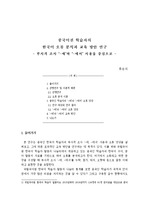

-
서지정보
· 발행기관 : 어문연구학회
· 수록지 정보 : 어문연구 / 96권 / 69 ~ 88페이지
· 저자명 : 한주희
초록
교착어인 한국어에서 조사는 명사구에 결합하여 격을 표시할 뿐만 아니라 의미를 한정해 주기도 한다. 주격이나 목적격처럼 문법 기능 표지로서의 조사를 구조격 혹은 문법격으로 정의하고, 부사격처럼 어휘적 속성을 지니는 격조사를 어휘격 혹은 의미격이라고 하는 것을 알 수 있다. 부사격 조사를 ‘어휘격’으로 보는 이유는 ‘주격, 목적격’과 달리 ‘격기능’을 나타냄과 동시에 어휘적(의미적) 속성의 정도가 커서 ‘생략’이 자유롭지 않다는 데에 있다.
한국어는 SOV 언어로 서술어 앞에 두 개의 명사구가 위치한다. 이러한 유형의 언어에서는 두 개의 명사구를 구분하는 장치가 필요하고, 이러한 필요성 때문에 발달한 것이 주격 조사인 ‘이/가’와 목적격 조사인 ‘을/를’이다. 분석적 격 표지가 발달한 한국어의 유형적 특성상 격 표지는 명사나 동사와 같은 실사에서 후치사로, 후치사에서 격 접미사로 발달해 오는 양상을 보여 주므로 문법화의 정도가 강한 주격, 목적격에도 어느 정도 의미 기능이 온존해 있다고 본다. 따라서 격조사의 실현 여부에 따라 의미 차이가 존재한다. 하지만 상대적으로 부사격 조사는 구조격에 비해 문법화의 정도가 약하므로 어휘적 속성이 강하게 존재하여 선행 명사구에 의미역을 부여할 수도 있고 생략이 어렵다. 이러한 한국어 격조사의 특징을 고려한다면, 동일한 부사격 조사라고 할지라도 문법화의 정도에 차이가 있을 가능성도 존재한다.
현재에 합의된 부사격 조사는 이미 통시적으로 문법화의 과정을 거친 것이라고 할지라도, 주격이나 목적격이 실사에서 문법화된 것일 수 있다는 것처럼 부사격 조사도 시간이 흐른 후에 주격, 목적격처럼 높은 수준으로 문법화가의 정도가 진행되어 어휘적 의미가 약해질 수도 있을 것이다.. 이 연구에서는 이러한 가정 하에 부사격 조사 내에서의 문법화의 정도가 차이가 있는지를 확인해 보고자 한다. 부사격 조사의 유형별 분포를 통해, 격조사로의 대체 여부, 작용역을 도입하여 조사간의 중첩 양상을 분석하여, 문법화 정도의 차이 가능성을 타진해 보았다.영어초록
This paper aims to explain the grammaticalization rank of adverbial case markers through the combination patterns. And also the scope is imposed to explain the function of them. Adverbial case markers show various semantic and syntactic functions. Concretely they represent semantic attributes comparing to other structural case markers.
Korean language is called SOV, with two noun phrases placed before a verb. In this type of language, it is necessary to distinguish between two noun phrases so the nominative case and the objective case have been developed. Due to the type of Korean language with strong case markers, the case markers have been changed from the lexicon to the postposition.
In Korean language, the case markers not only refer the cases to noun phrases but also limits their lexical meaning. The nominative or the objective case is called structural cases by means of a sentence system and adverbial cases are called as lexical cases. The reason why the adverbial cases could be omitted due to their degree of lexical qualities. In addition to that even the adverbial cases could have the different degree of lexical and grammatical meanings.
Therefore they could be replaced by other case markers on the basis of the semantic criteria. Their combination patterns refer to the grammaticalization rank because preceding case markers have more lexical attributes. In addition to this, some case markers could be replaced by other case markers such as ‘i/ka, eul/reul’. According to the distributions, this paper arrives at the following conclusion ‘ro>ey, wa/gwa>ege, eseo’. Korean Copus supports the results.
This paper the first step explaining the grammaticalization rank of adverbial case markers.참고자료
· 없음태그
-
자주묻는질문의 답변을 확인해 주세요

꼭 알아주세요
-
자료의 정보 및 내용의 진실성에 대하여 해피캠퍼스는 보증하지 않으며, 해당 정보 및 게시물 저작권과 기타 법적 책임은 자료 등록자에게 있습니다.
자료 및 게시물 내용의 불법적 이용, 무단 전재∙배포는 금지되어 있습니다.
저작권침해, 명예훼손 등 분쟁 요소 발견 시 고객센터의 저작권침해 신고센터를 이용해 주시기 바랍니다. -
해피캠퍼스는 구매자와 판매자 모두가 만족하는 서비스가 되도록 노력하고 있으며, 아래의 4가지 자료환불 조건을 꼭 확인해주시기 바랍니다.
파일오류 중복자료 저작권 없음 설명과 실제 내용 불일치 파일의 다운로드가 제대로 되지 않거나 파일형식에 맞는 프로그램으로 정상 작동하지 않는 경우 다른 자료와 70% 이상 내용이 일치하는 경우 (중복임을 확인할 수 있는 근거 필요함) 인터넷의 다른 사이트, 연구기관, 학교, 서적 등의 자료를 도용한 경우 자료의 설명과 실제 자료의 내용이 일치하지 않는 경우
“어문연구”의 다른 논문도 확인해 보세요!
-
공적 말하기의 쟁점과 교육 방안 25 페이지
이 논문은 대학생들의 수업발표를 중심으로 공적 말하기의 개념에 대한 이해와 교육의 필요성 및 교육 방안을 모색하는 데 목적이 있다. 고등학교까지의 입시교육은 학생들의 사고력과 의사소통 능력의 배양에 부정적인 영향을 끼쳤다고 볼 수 있다. 특히 학생들이 공적인 상황에 대해 제대로 인식하지 못하고 생각나는 대로 어휘와 문장을 구사하고, 그에 수반되는 비언어적인.. -
‘피동사-능동사’ 의미 비대칭 양상 연구 - ‘걸리다-걸다’를 중심으로 30 페이지
본고의 목적은 한국어의 다의어 특징을 갖고 있는 피동사의 의미와 이에 대응되는 능동사의 의미 차이를 고찰하는 데 있다. 최근에도 한국어 피동교육을 중심으로 한 연구가 지속적으로 나오고 있지만 대부분 문장구조나 문형 차원에서 논의를 진행한 것으로 피동문의 핵심인 피동사의 의미에 대한 연구는 거의 찾아볼 수 없다. 한국어 학습자들에게 피동사와 능동사의 관계를 ..
찾으시던 자료가 아닌가요?
지금 보는 자료와 연관되어 있어요!
문서 초안을 생성해주는 EasyAI






